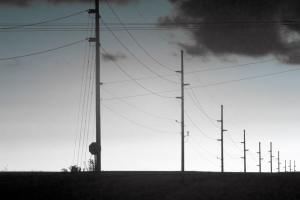
Inflation Reduction Act incentives are expected to help accelerate states’ clean energy transitions, but a new bottleneck is emerging that may blunt the federal law’s benefits over the next few years.
A new report by the Natural Resources Defense Council finds that states partially or entirely in PJM regional transmission territory may not be able to achieve their renewable portfolio standard, or RPS, targets through 2027 because of the long queue for connecting projects to the electric grid.
“Given the lack of wiggle room between estimated PJM supply and statewide demand, states should be concerned about having enough renewable energy to meet their needs,” the study says.
Meanwhile, more ambitious energy decarbonization goals that many cities and states have adopted are even more precarious because of the delays.
“The RPS is a very old-school policy that most states have in place, and even those standards are at risk,” said NRDC policy analyst Dana Ammann, lead author of the report. “Greenhouse gas targets that states have worked so hard to implement will require so much more renewable development” than will be able to get online in coming years because of the interconnection delays.
Illinois, for example, will likely struggle to meet its RPS goal of 40% clean energy by 2030 and 100% clean energy by 2050 regardless of interconnection problems, and the long queue will likely exacerbate the situation. Ohio has already met its lackluster 8.5% RPS, but interconnection delays will likely stymie wind and solar development that would have been driven by the market and other targets, experts say.
Get the most important energy news of the week delivered directly to your inbox.
PJM is the nation’s largest regional grid operator, with a territory that spans all or parts of 13 states from the Midwest to the Mid-Atlantic, plus the District of Columbia. Of nearly 2,500 utility-scale projects totaling 250 gigawatts of capacity waiting in interconnection queues nationwide today, 95% of them are in PJM’s queue, according to PJM and the NRDC report.
The NRDC report cites predictions by the Princeton ZERO Lab that PJM will see an additional gigawatt of renewable energy projects entering the queue annually going forward.
In a 2022 company Q&A, PJM vice president of planning Ken Seiler said that the influx of renewable proposals means the projects PJM needs to study before interconnecting to the grid has “basically tripled in four years,” and “in 2020, PJM performed more studies than all other regional transmission organizations combined.”
The NRDC report quantifies the estimated solar and wind in the PJM interconnection queue for each PJM state, taking into account the rate of projects likely to be withdrawn from the queue and the typical capacity factor of projects — how much energy would actually be generated.
The report shows that for PJM states to meet their renewable portfolio standard goals, 150,000 total gigawatt-hours of solar and wind would be needed by 2028. Meanwhile, incentives in the Inflation Reduction Act could spark demand for more than 225,000 gigawatt-hours by 2028, and more than 150,000 by 2025.
Currently, less than 100,000 gigawatt-hours of renewables are available in PJM states. Illinois alone will need almost 30,000 gigawatt-hours of renewables by 2028 to meet its RPS goals.
The study looks only at delays in interconnection request processing, not the process of building new transmission lines often needed to get renewable energy to load centers. The interconnection process is aimed at studying transmission needs when new power plants or renewables are proposed, and allocating the costs for that transmission to the power producers.
PJM spokesperson Susan Buehler said PJM is working hard to clear its queue, but delays in renewable construction are also being caused by other factors. “Currently there are 44,000 MW mostly renewable generation resources that have cleared the PJM study process but have yet to be built due to factors unrelated to PJM, including supply chain and siting,” Buehler said by email.
Smaller distributed generation — rooftop and community solar — does not need to interconnect through PJM, but NRDC included estimated growth of such distributed generation in its projections about whether states would reach their RPS.
“There is a limited role for [distributed generation] because of the efficiency of utility-scale” versus rooftop solar, Ammann noted. “And there are still interconnection processes for utilities, which are not without their delays.”
Illinois’ renewable portfolio standard stipulates that almost all the renewable generation needs to be in the state, as opposed to out-of-state renewable energy credits.
The NRDC report indicates that even once wind and solar already in the queue are connected and start generating, Illinois will be short of its RPS goals by about 5,000 gigawatt-hours.
Only northern Illinois, utility ComEd’s service territory, is in PJM. The rest of the state is part of the MISO regional transmission organization. Ammann noted that wind and solar projects proposed “deep in MISO territory” are also seeking to connect to PJM’s grid.
“They can get the benefits of connecting to the PJM grid,” Ammann said. “Interregional transmission, deep coordination between the RTOs” — regional transmission organizations — “will definitely be necessary, especially in a multi-RTO state like Illinois.”
David Kolata, executive director of the Citizens Utility Board in Illinois, noted that the state has no problems with energy supply, especially given its nuclear plants. But it has an important role to play as a clean energy supplier for the region.
“We’re in the midst of an energy transition that potentially has really tremendous consumer and environmental value, and we’ve made a lot of strides in this direction, but in order to keep the progress going we need to make sure we’re building more renewables,” he said. “There are a lot of projects ready to go, but they can’t get connected to the grid. Especially as we have transportation electrification and as buildings electrify, it’s going to be important that we build new renewables.”
Illinois’ renewable portfolio standard could make it harder for nearby states to meet their goals, as Illinois will prioritize building new wind and solar resources and accounting for those renewable credits in-state, rather than allowing credit for that renewable energy to be exported to states that allow out-of-state renewables to count toward their goals.
In 2021, Illinois wind was credited toward RPS compliance in PJM states Delaware, Maryland, New Jersey, Ohio, and Pennsylvania, according to the NRDC report.
In PJM, Virginia has comparable goals to Illinois — 100% renewables by 2050, but a quarter of the credits can come from out-of-state generation.
States with more flexible RPS policies may find it easier to meet their targets even with the interconnection delays, but without the real emissions reductions that come from rigorous RPS standards.
Ohio is likely to continue exporting renewables — or rather, credits for them — to other states to help meet their targets. The queued utility-scale solar proposed in Ohio could almost double the state’s total renewable output, according to the NRDC report.
Pennsylvania has already far surpassed its RPS of 8% renewable energy, in part thanks to its hydroelectric generation. Pennsylvania has a relatively small amount of wind energy and a sizable chunk of utility-scale solar proposed in the interconnection queue.
In 2022, PJM came to an agreement with the Federal Energy Regulatory Commission to reform its interconnection process, including by reviewing interconnection requests in batches rather than individually.
The reforms will also prioritize proposals that are more developed and more likely to proceed, to reduce withdrawals from the queue that slow down the process. The PJM independent market monitor estimates that less than 13% of megawatt capacity in the queue will actually reach fruition because of project withdrawals.
“PJM advanced landmark reforms to speed the interconnection queue that were overwhelmingly approved by PJM stakeholders and the Federal Energy Regulatory Commission,” Buehler said. “PJM will continue to work constructively with all of our stakeholders, including the NRDC, on ways to go even faster. Reliability of the grid is our focus and priority.”
The reforms take effect this summer, and renewable projects put on an expedited fast track will be considered under the new rules. The backlog of proposals filed before 2021 still need to be dealt with under the old procedures. Most new projects — like the expected “onslaught” incentivized by the Inflation Reduction Act, as NRDC phrased it — can’t be considered until the interconnection backlog is gone, likely in 2026, according to PJM and advocates’ estimates.
“The great thing about the IRA is the money doesn’t expire,” Ammann said. “But we’re all familiar with the urgent messaging around climate change. Time is of the essence.”
Ammann said there’s not much that stakeholders can do to reduce the current backlog, but PJM can avoid future delays by doing proactive transmission planning, which is not a part of the reforms.
“Status-quo interconnection processes exacerbate these challenges through piecemeal transmission upgrades rather than through long-term, proactive planning,” the report says.
States can also help by enacting their own transmission planning processes and paying for new long-distance transmission, rather than leaving the payments to individual companies and utilities. The state is likely to then recoup costs from ratepayers or taxpayers. New Jersey has such a process in place, and Maryland recently adopted the concept.
“That shifts the cost to states, and lets construction start earlier,” said NRDC senior advocate Tom Rutigliano. “It’s more about the timing than who pays. The state is capable of stepping up in the short-term and funding a project that’s out of reach of developers.”
There are about 30 GW of offshore wind projects in the queue off the coasts of New Jersey, North Carolina, Virginia and Maryland. But these projects are expected to face particular delays related to lawsuits, permitting and technology.
Offshore wind does not currently figure into interconnection requests in the Midwest. Illinois legislators proposed a bill last year to support offshore wind, with a proposal floated for a wind farm off the coast of Chicago’s Southeast Side, but the idea faced opposition and the bill has not progressed.
Ultimately, Ammann and Rutigliano said, state transmission planning, more offshore wind, and other ways to maximize renewable development, speed the interconnection process and promote transparency are all crucial.
“Renewable growth smashes every expectation for how much it’s going to increase,” Ammann said. “So we need to be thinking creatively and outside the box.”



